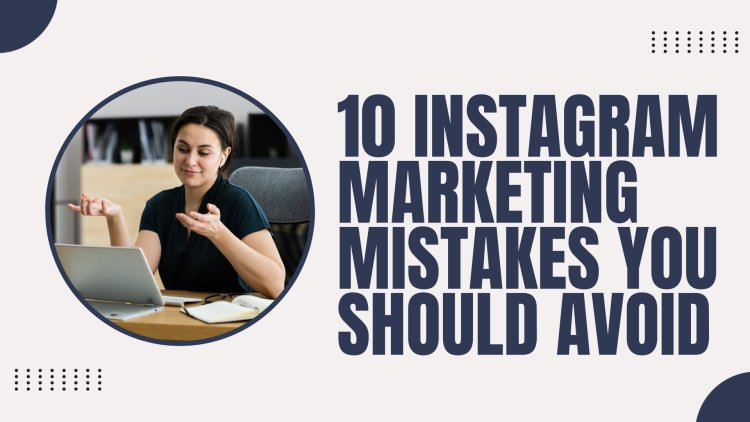10 Instagram Marketing Mistakes You Should Avoid

What is Instagram?
Instagram is a popular social media platform that allows its users to share photos and videos with their followers. With over 1 billion active monthly users, Instagram has become a powerful tool for personal and business branding, marketing, and networking. The platform also includes features such as Stories, Reels, IGTV, and shopping, making it a versatile and engaging space for users to connect and share content. As one of the most used social media platforms worldwide, Instagram has transformed the way people share their lives, interests, and businesses online.
10 Common Mistakes to Avoid
1. Ignoring influencer management tools: Many businesses make the mistake of not using influencer management tools to track the performance of their influencer marketing campaigns. These tools are essential for identifying the right influencers, managing partnerships, and measuring the success of collaborations.
2. Overlooking micro-influencers: Another common mistake is disregarding the potential of micro-influencers. These influencers may have a smaller following, but they often have highly engaged audiences and can offer a more targeted approach to reach specific demographics.
3. Not setting clear goals: Failing to establish clear goals for Instagram marketing can lead to aimless content creation and ineffective campaigns.
4. Neglecting to optimize Instagram profiles: Many businesses miss out on valuable opportunities by not fully optimizing their Instagram profiles with relevant keywords, a strong bio, and a call-to-action.
5. Ignoring analytics: Without monitoring and analyzing Instagram analytics, it's challenging to understand what content is resonating with the audience and how to improve future efforts.
6. Inconsistent posting: Inconsistency in posting can lead to a drop in engagement and can affect the overall performance of Instagram marketing efforts.
7. Overlooking storytelling: Brands often make the mistake of purely promoting products or services, neglecting the power of storytelling to create a deeper connection with their audience.
8. Not leveraging user-generated content: User-generated content can be a powerful tool for building trust and loyalty, yet many businesses overlook this valuable resource.
9. Focusing solely on numbers: While it's important to reach a larger audience, focusing solely on follower count can lead to a lack of genuine engagement and connection with the audience.
10. Ignoring community interaction: Engaging with the Instagram community is essential for building a strong brand presence, yet many businesses fail to actively interact with their followers.
Utilizing influencer management tools and partnering with micro-influencers can help businesses avoid these common mistakes and maximize engagement on Instagram. These tools provide valuable insights and streamline the process of identifying and collaborating with the right influencers. Partnering with micro-influencers can also lead to higher engagement rates and a more authentic connection with the audience, ultimately driving better results for Instagram marketing efforts.
1. Not Having a Clear Target Audience
When it comes to successful marketing and business strategies, having a clear target audience is essential. Without a defined focus on who your ideal customer is, it becomes difficult to create tailored and effective messaging, products, and services that resonate with potential customers. In this article, we will discuss the challenges and consequences of not having a clear target audience, and explore ways to identify and understand your ideal customer for the success of your business.
Establishing the Right Target Audience
Our target audience is primarily composed of young adults in the 18-35 age group, located in urban areas. They are passionate about health and wellness, sustainability, and personal development. Many of them are working professionals in fields like marketing, technology, and creative industries. Their pain points include stress management, work-life balance, and finding meaningful connections in their busy lives.
We speak directly to our audience, addressing their specific needs and issues by creating content that focuses on self-care, productivity tips, and creating a sense of community. Our goal is to provide them with a unique experience on our platform, one that they enjoy and value.
By understanding our target audience's interests and pain points, we aim to create content that resonates with them on a personal level, ultimately providing them with solutions to their challenges and enhancing their overall well-being.
Analyzing Your Target Audience’s Behaviour and Interests
The target audience for our analysis is active on Instagram, where they engage with a variety of content and follow specific influencers. Using Instagram analytics tools, we can gather data on their engagement and preferences to gain insights into their behavior and interests. By looking for patterns in the type of content they respond to and the influencers they follow, we can understand their interests and behaviors more effectively. This includes analyzing the types of posts they like, comment on, and share, as well as the influencers who generate the most interaction from them. Keywords related to our analysis include Instagram, analytics tools, engagement, preferences, influencers, and interests. Understanding our target audience's behavior and interests on Instagram allows us to tailor our content and marketing strategies to better resonate with them and ultimately achieve our goals.
2. Not Having a Clear Marketing Strategy
When it comes to running a successful business, having a clear marketing strategy is essential for reaching and attracting the right customers. Without a clear plan in place, businesses can struggle to effectively promote their products or services, allocate resources wisely, and measure the success of their efforts. In the following section, we will explore the potential consequences of not having a clear marketing strategy and how it can impact a business's overall success. We will also discuss some practical steps that businesses can take to develop and implement a strong marketing strategy to achieve their goals.
Defining Your Goals and Objectives
When defining the goals and objectives for your ad campaign, it is crucial to align them with your overall marketing strategy and desired outcomes. Specific goals could include increasing website traffic, driving user engagement, building brand awareness, or increasing sales and app installations.
For example, if your marketing strategy is focused on growing brand awareness, your ad campaign's objective might be to increase social media engagement and reach a wider audience. On the other hand, if your goal is to drive sales and app installations, your ad campaign should focus on targeting potential customers with compelling calls to action.
By clearly defining your ad goals and objectives, you can tailor your ad content, targeting, and messaging to achieve the desired outcomes. This also helps in measuring the success of your campaigns and making informed decisions for future marketing efforts.
Ultimately, understanding your ad campaign's goals and objectives is essential for creating effective and impactful advertisements that align with your broader marketing strategy.
Setting Up an Effective Content Plan
Setting up an effective content plan is crucial for achieving the specific goal of an ad. To begin, it's essential to determine the specific goal, whether it is to increase website traffic, drive user engagement, build brand awareness, or boost sales or app installations. Once the goal is identified, the next step is to tailor the content to achieve that goal.
For example, if the goal is to increase website traffic, the content plan should focus on creating valuable and shareable content that drives traffic to the website. This could include blog posts, videos, or infographics that provide valuable information and encourage users to visit the website for more.
Similarly, if the goal is to drive user engagement, the content plan should include strategies such as creating interactive content, running contests or polls, and responding to user comments and messages on social media platforms.
To build brand awareness, the content plan should focus on creating consistent and recognizable branding across all platforms, telling engaging brand stories, and collaborating with influencers and other brands.
By tailoring the content plan to the specific goal, businesses can effectively increase website traffic, drive user engagement, and build brand awareness, ultimately boosting sales and app installations.
Identifying the Right Platforms for Your Business Model
When identifying the right platforms for your business model, it is essential to consider key elements such as your target audience, product/service offering, and value proposition. Research the various digital platforms available, including social media, e-commerce, and industry-specific websites, to determine which ones align best with your business model.
Consider factors such as audience demographics, user behaviors, and marketing goals when selecting the right platforms for your business. For instance, if your target audience is young adults and your product/service offering is visually appealing, platforms like Instagram and TikTok may be suitable for your business. On the other hand, if your business model focuses on selling products directly to consumers, e-commerce platforms such as Amazon or Etsy may be more suitable.
It is crucial to understand where your target audience spends their time online and which digital platforms will enable you to effectively communicate your value proposition. By carefully considering these factors, you can ensure that you effectively reach and engage with your target audience on the most suitable digital platforms.
3. Failing to Utilize Visual Content Effectively
In today's digital age, visual content has become a powerful tool for engaging audiences and conveying messages in a compelling and effective way. However, many individuals and businesses struggle to harness the full potential of visual content, leading to missed opportunities and underwhelming results. In this section, we will discuss the common pitfalls and mistakes that individuals and businesses make when it comes to utilizing visual content, and provide practical tips for how to effectively incorporate visual elements into your communications and marketing strategies. Whether it's on social media, websites, or in presentations, the importance of harnessing the power of visual content cannot be overstated, and we'll explore ways to ensure you make the most of this valuable resource. So, let's dive into the topic of failing to utilize visual content effectively and learn how to elevate our visual storytelling skills.
Leveraging Videos, Images, and Graphics Appropriately
In today's digital landscape, leveraging videos, images, and graphics is crucial for engaging and resonating with your audience. Visual content has the power to capture attention, convey emotions, and tell a story in a way that text alone cannot. By integrating visuals into your content strategy, you can create a more impactful and memorable experience for your audience.
It's important to ensure that the visuals you use align with your brand identity and messaging. Avoid overproduced or random visuals that may not connect with your audience. Instead, focus on creating authentic, in-the-moment content that speaks to your audience's interests and preferences. This approach builds trust and strengthens the relationship between your brand and your audience.
By incorporating visuals that resonate with your audience, you can effectively communicate your message and leave a lasting impression. Whether it's through social media posts, website content, or marketing materials, the use of visuals can enhance the overall experience for your audience. In today's visual-centric world, using visuals to create authentic, in-the-moment content is key to capturing and maintaining your audience's attention.
Ensuring Quality Visual Content is Created for Each Posting
In today's digital age, creating high-quality visual content for each Instagram post is essential for maintaining a strong brand reputation and increasing follower engagement. Poorly produced visuals can have a negative impact on how a brand is perceived by its audience, ultimately affecting consumer trust and loyalty. In contrast, high-quality visuals can enhance a brand's image, attract new followers, and keep existing followers engaged.
To ensure that each image meets Instagram's quality and size guidelines, it's important to use photo editing tools to enhance the visual appeal. These tools can help improve the overall composition, lighting, and color balance of the image. Additionally, utilizing Instagram filters can also help improve the overall aesthetic of the photo.
When using photo editing tools, it's vital to maintain a consistent visual style that aligns with the brand's identity. This can help create a cohesive and professional-looking Instagram feed while also maximizing the impact of each post.
Ultimately, by creating high-quality visual content for each Instagram post, brands can effectively capture the attention of their audience, strengthen their brand reputation, and increase follower engagement.
4. Not Tracking Performance Metrics
When it comes to assessing the success of a project or business, tracking performance metrics is often a key component. However, there are times when not tracking performance metrics may be necessary or beneficial. In some cases, focusing too much on specific metrics can lead to a narrow perspective and overlook other important factors contributing to overall success. It's important to consider the potential drawbacks and limitations of solely relying on performance metrics, and explore alternative methods of evaluating progress and effectiveness. In this section, we will discuss the potential benefits of not tracking performance metrics, as well as alternative approaches to evaluating success and making data-driven decisions. We will also explore situations where not tracking performance metrics may be more appropriate or advantageous for achieving long-term goals.
Determining Key Performance Indicators (KPIs)
The specific goals for my Instagram posts are to increase reach, engagement, and ultimately drive product purchases. Each post will be designed to build and strengthen customer relationships, gather feedback, and drive conversions. By focusing on creating visually appealing and engaging content, I aim to increase reach and engagement with my audience, ultimately reducing the cost per click and maximizing return on investment.
To measure the effectiveness of my Instagram posts, I will track specific KPIs for each post. These KPIs may include reach, engagement rate, click-through rate, conversion rate, and return on ad spend. By setting clear and specific KPIs for each post, I can better guide my content strategy and make data-driven decisions to optimize future posts.
Incorporating keywords related to my business and industry in my posts will also help increase visibility and engagement, ultimately driving product purchases. By consistently monitoring and analyzing the performance of my Instagram posts based on these KPIs, I can continually refine and improve my content strategy to better meet my goals.
Implementing Analytics Tools to Monitor Progress & Make Adjustments
In order to effectively monitor the progress of Instagram marketing efforts and make necessary adjustments, a combination of social media analytics tools can be utilized. Facebook Ads Manager, Instagram Insights, and Hootsuite Social Advertising are powerful tools that can help in tracking the success of Instagram marketing campaigns. Facebook Ads Manager allows for detailed tracking of ad performance, while Instagram Insights provides in-depth analytics on follower demographics, post performance, and audience engagement. Hootsuite Social Advertising helps in managing and measuring social media campaigns across various platforms.
Additionally, Google Analytics can be used to monitor shares, traffic, and customer conversion from Instagram. This data can be used to analyze the quality of followers, post popularity, and demographic segmentation. It is crucial to track metrics such as engagement, customer conversion, and trends in buying decisions, in order to derive actionable insights from customer purchases. By utilizing these analytics tools, businesses can better understand their Instagram marketing efforts, identify areas for improvement, and make necessary adjustments for more effective campaigns.












